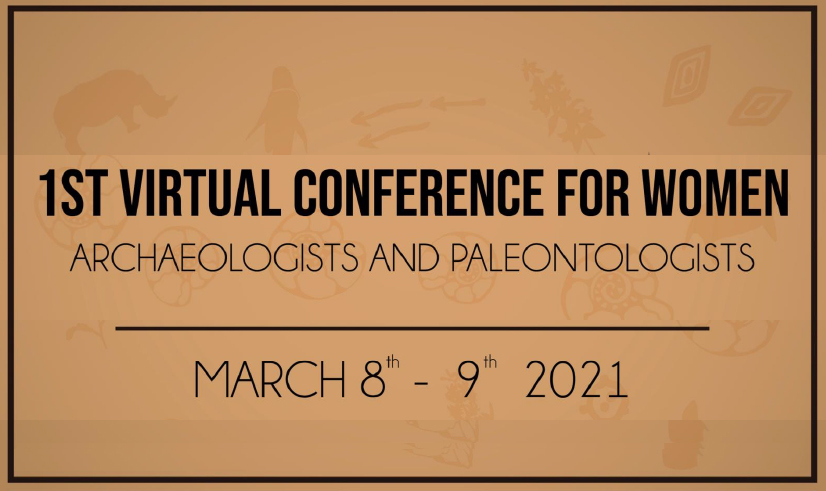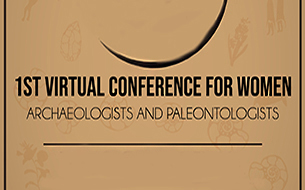1st Conference for Women Archaeologists and Paleontologists
- niveau 1 niveau 2 niveau 3
- document 1 document 2 document 3

Descriptif
Les femmes sont encore minoritaires dans la recherche en France : 35% de femmes parmi les chercheuses et chercheurs dans la recherche publique. Malgré un manque de chiffres, le constat d’une sous-représentation des femmes aux postes de chercheuses CNRS, maîtres de conférences ou professeures est également partagé dans nos disciplines spécifiques. Elles sont en revanche bien plus nombreuses à disposer d’un poste non-permanent et/ou à temps partiel, donc précaire.
Ainsi, les travaux des chercheuses non-titulaires d’un poste permanent contribuent quotidiennement au renouvellement des connaissances sur les populations passées, humaines et non-humaines, et les milieux dans lesquels elles ont vécu. En valorisant leurs récentes contributions, cet événement scientifique sera l’occasion de donner plus de visibilité aux jeunes chercheuses, ainsi que de tisser des liens entre l'archéologie et la paléontologie, de partager des savoirs, des approches et d’initier des discussions voire des collaborations.
Ce colloque traite des récents apports à l’étude des populations et des environnements passés, articulé autour de différents axes : 1) Expérimentations, référentiels actualistes, sources anciennes et autres approches méthodologiques, 2) Territoires, mobilité et (paléo)biogéographie, 3) Ressources et stratégies d’exploitation, 4) Changements environnementaux et adaptations biologiques.
Vidéos
Sensivity analysis to morphological changes of the shoulder joint: application to percussio…
Sensivity analysis to morphological changes of the shoulder joint: application to percussion gestures during Oldowan debitage / Alicia Blasi-Toccacceli, in colloque "1st Virtual Conference for
"Ouranopithecus macedoniensis" (late Miocene, Greece): analysis of mandibular fragments using …
Ouranopithecus macedoniensis (late Miocene, Greece): analysis of mandibular fragments using 3D geometric morphometrics / Melania Ioannidou, in colloque "1st Virtual Conference for Women
Comminution capabilities of extant and fossil anthropoids during molar intercuspation: a preliminar…
Comminution capabilities of extant and fossil anthropoids during molar intercuspation: a preliminary experiment using a chewing simulator / Axelle E. C. Walker, in colloque "1st Virtual Conference for
New sperm whale cranium from the late Miocene and a revised family attribution for the small crown …
New sperm whale cranium from the late Miocene and a revised family attribution for the small crown physeteroid Thalassocetus / Apolline Alfsen, in colloque "1st Virtual Conference for Women
What is shaping the brain? A perspective on brain size evolution in carnivorans / Margot…
What is shaping the brain? A perspective on brain size evolution in carnivorans / Margot Michaud, in colloque "1st Virtual Conference for Women Archaeologists and Paleontologists. Nouveaux
Postnatal shape changes in the rodent mandible at a macroevolutionary scale / Morgane Dubied
Postnatal shape changes in the rodent mandible at a macroevolutionary scale / Morgane Dubied, in colloque "1st Virtual Conference for Women Archaeologists and Paleontologists. Nouveaux apports à l
Cranial vault healing in modern humans: input of archaeological and clinical data / Aliéno…
Cranial vault healing in modern humans: input of archaeological and clinical data / Aliénor Lepetit, in colloque "1st Virtual Conference for Women Archaeologists and Paleontologists. Nouveaux
A transdisciplinary approach to reconstruct the Nilotic socio-ecosystem in Luxor west bank during t…
A transdisciplinary approach to reconstruct the Nilotic socio-ecosystem in Luxor west bank during the Ptolemaic period (3rd-1st centuries BC.) / Giulia Nicatore, in colloque "1st Virtual Conference
From monoliths to megaliths: a new approach on the megalithic burials of southwestern France / Bosc…
From monoliths to megaliths: a new approach on the megalithic burials of southwestern France / Boscus Sarah, in colloque "1st Virtual Conference for Women Archaeologists and Paleontologists. Nouveaux
Tracing Human Ancestral Migration from its Symbiotic Bacteria / Alexia Nguyen Trung
Tracing Human Ancestral Migration from its Symbiotic Bacteria / Alexia Nguyen Trung, in colloque "1st Virtual Conference for Women Archaeologists and Paleontologists. Nouveaux apports à l’étude des
Foragers and their symbolic landscape. Understanding the role of rock art in the territoriality of …
Foragers and their symbolic landscape. Understanding the role of rock art in the territoriality of Later Stone Age Matobo populations / Léa Jobard, in colloque "1st Virtual Conference for Women
Towards a tracking of past bird seasonal migrations through geological times: what could isotopes t…
Towards a tracking of past bird seasonal migrations through geological times: what could isotopes tell us? / Anaïs Duhamel, in colloque "1st Virtual Conference for Women Archaeologists and
Study of human group behaviors during the Last Glacial Maximum in the east Carpathian area from zoo…
Study of human group behaviors during the Last Glacial Maximum in the east Carpathian area from zooarchaeological remains / Laëticia Demay, in colloque "1st Virtual Conference for Women Archaeologists
From sooty speleothems analysis to the study of occupation dynamics of caves by prehistoric societi…
From sooty speleothems analysis to the study of occupation dynamics of caves by prehistoric societies / Ségolène Vandevelde, in colloque "1st Virtual Conference for Women Archaeologists and
An analysis of Iron Age Scottish wetland deposition practices /Tiffany Treadway
An analysis of Iron Age Scottish wetland deposition practices / Tiffany Treadway, in colloque "1st Virtual Conference for Women Archaeologists and Paleontologists. Nouveaux apports à l’étude des
Gender Trouble: towards a deconstruction of binarity in archaeology / Laura Mary
Gender Trouble: towards a deconstruction of binarity in archaeology / Laura Mary, in colloque "1st Virtual Conference for Women Archaeologists and Paleontologists. Nouveaux apports à l’étude des
“Feeling at home”: integration of Polynesian women inside pre-existing societies of Vanuatu (Melane…
“Feeling at home”: integration of Polynesian women inside pre-existing societies of Vanuatu (Melanesia) / Wanda Zinger, in colloque "1st Virtual Conference for Women Archaeologists and Paleontologists
Study on the origins of iron metallurgy in North-East Madagascar (11th-16th century): Reinvention o…
Study on the origins of iron metallurgy in North-East Madagascar (11th-16th century): Reinvention or technology transfer? / Mélissa Morel, in colloque "1st Virtual Conference for Women Archaeologists
Identification of embalming material of bird mummies through molecular and compound-specific δ13C a…
Identification of embalming material of bird mummies through molecular and compound-specific δ13C analyses / Alex Malergue, in colloque "1st Virtual Conference for Women Archaeologists and
New insights into the study of past populations: archeozoology and cementochronology in the Middle …
New insights into the study of past populations: archeozoology and cementochronology in the Middle Palaeolithic / Audrey Roussel, in colloque "1st Virtual Conference for Women Archaeologists and
Neanderthal facing climatic disruptions of the MIS 4 in southwestern France: between cynegetic choi…
Neanderthal facing climatic disruptions of the MIS 4 in southwestern France: between cynegetic choices and environmental constraints / Christelle Dancette, in colloque "1st Virtual Conference for
Retouched bone tools: which place in Neanderthal technical systems? / Emma Bernard
Retouched bone tools: which place in Neanderthal technical systems? / Emma Bernard, in colloque "1st Virtual Conference for Women Archaeologists and Paleontologists. Nouveaux apports à l’étude des
Analysis of Artefact Form: the application of morphometric methods to archaeology / Renata Pedroso …
Analysis of Artefact Form: the application of morphometric methods to archaeology / Renata Pedroso de Araujo, in colloque "1st Virtual Conference for Women Archaeologists and Paleontologists. Nouveaux
The middle triassic palaeoflora of monte Prà della Vacca / Kühwiesenkopf (NE Italy)-new investigati…
The middle triassic palaeoflora of monte Prà della Vacca / Kühwiesenkopf (NE Italy)-new investigations / Giuseppa Forte, in colloque "1st Virtual Conference for Women Archaeologists and
Revising the microvertebrates from the Palaeolithic site of Kalamakia (Mani Peninsula), Greece / Ko…
Revising the microvertebrates from the Palaeolithic site of Kalamakia (Mani Peninsula), Greece / Kolendrianou Maria, in colloque "1st Virtual Conference for Women Archaeologists and Paleontologists.
Intervenants et intervenantes
Diplômée du Master Systématique, Évolution, Paléontologie au Musée national d'Histoire naturelle (Paris, France) en 2020. Spécialisée dans les mammifères marins et leur adaptation au milieu aquatique (2021)
Doctorante au Musée d'archéologie et d'ethnologie de l'Université de São Paulo (Brésil) (en 2021)
Doctorante au sein de l"équipe "Sociétés et milieux des populations de chasseurs-cueilleurs-collecteurs" du laboratoire Travaux et Recherches Archéologiques sur les Cultures, les Espaces et les Sociétés (TRACES) à l'Université Toulouse-Jean Jaurès (France) (2021)
Doctorante au sein du laboratoire Paléontologie Évolution Paléoécosystèmes Paléoprimatologie (Palevoprim) de l'Université de Poitiers (2021)
Doctorante au sein du Laboratoire "Travaux et Recherches Archéologiques sur les Cultures, les Espaces et les Sociétés" (TRACES), dans l'équipe Préhistoire Récente du Bassin Méditerranéen, à l'Université de Toulouse 2 Jean Jaurès (2021)
Doctorante au sein de l'équipe "Sociétés et milieux des populations de chasseurs-cueilleurs-collecteurs" du laboratoire Travaux et Recherches Archéologiques sur les Cultures, les Espaces et les Sociétés (TRACES) à l'Université Toulouse-Jean Jaurès (2021)
Docteur en Histoire, Art et Archéologie, Laëtitia Demay est chercheure associée à l'unité de recherche Histoire Naturelle de l'Homme Préhistorique (HNHP), dans l'équipe NOMADE « Néandertaliens et Hommes anatomiquement modernes : comportements émergents, dynamique culturelle, mobilité territoriale » du Museum d'Histoire naturelle de Paris (2021)
Doctorante au laboratoire Biogéosciences au sein de l'équipe BioMe (Émergence et maintien de la diversité) de l’Université Bourgogne Franche-Comté à Dijon (2021)
Étudiante en Master 2 paléontologie, sédimentologie et paléoenvironnement à l’ENS de Lyon (en 2021)
Collaboratrice scientifique au Museum of Nature South Tyrol (en 2021)
Doctorante en paléoanthropologie au Senckenberg Centre for Human Evolution and Palaeoenvironment, University of Tübingen (Allemagne) (2021)
Doctorante au sein de l'équipe "Sociétés et milieux des populations de chasseurs-cueilleurs-collecteurs" du laboratoire Travaux et Recherches Archéologiques sur les Cultures, les Espaces et les Sociétés (Traces) à l'Université Toulouse-Jean Jaurès et et à l’IFAS-Recherche de Johannesburg (2021)
Biologiste, doctorante au sein du laboratoire de Paléontologie and Stratigraphie du Département Géologie de l'Université de Patras (2021)
Doctorante au sein du laboratoire Éco-anthropologie et ethnobiologie du Muséum d'Histoire Naturelle de Paris (2021)
Etudiante en Master 2 STPE (Sciences de la Terre et des Planètes) co-habilité Université Lyon 1 et ENS Lyon, au sein du Laboratoire de Géologie de l'Université Lyon 1 (LGL-TPE, Villeurbanne). Spécialité : archéologie moléculaire (2021)
Archéologue restauratrice de matériel archéologique, fondatrice de Paye Ta Truelle
Biologiste de l'évolution, post-doctorante au Department of African Zoology du Royal Museum for Central Africa (MRAC) à Tervuren (Belgique) (2021)
Auteur d'une thèse en Biologie évolutive à Paris, Muséum national d'histoire naturelle en 2019.
Docteure en sciences de la terre de l'Université de Fribourg, Suisse (2022). Spécialisée en archéologie préhistorique, Âge des métaux
Doctorante au sein du laboratoire Biométrie et Biologie Évolutive (LBBE) à l'Université Claude Bernard-Lyon 1 (2021)
Auteure d'une thèse en génomique comparative soutenue à l'université Claude Bernard Lyon 1 en 2024
Auteure d'une thèse en archéologie environnementale à Paris 1 en 2024
Titulaire d'un master 2 en archéozoologie (laboratoire LAMPEA, univ. d'Aix-Marseille)
Auteure d'une thèse en Préhistoire à Université Côte d'Azur (2023)
Doctorante en anthropologie et archéologie à la School of History, Archaeology and Religion (SHARE) de l'Université de Cardiff (Pays de Galle) (2021)
Membre d'ArScAn - Archéologie environnementale - UMR 7041, en 2019. Co-fondatrice de l'association Archéo-Éthique. Auteur d'une thèse en archéologie, anthropologie, préhistoire à Paris 1 en 2019.
Doctorante au sein du laboratoire Paléontologie Évolution Paléoécosystèmes Paléoprimatologie (Palevoprim) de l'Université de Poitiers (2021)
Chercheuse dans les domaines de la bio-anthropologie et de l'archéologie au Muséum national d'histoire naturelle, membre de l'UMR 7194-Histoire naturelle de l'Homme préhistorique, Paris (en 2025)
Thèmes
- Archéologie préhistorique
- Archéozoologie
- Paléolithique
- Paléoenvironnement
- Paléoanthropologie
- Morphométrie
- Hominidés
- Néolithique
- Adaptation (biologie)
- Bactéries
- Géographie historique
- Holocène
- Hominidés fossiles
- Industrie lithique
- Métallurgie
- Paléobotanique
- Paléoclimatologie
- Paléoécologie
- Paléogéographie
- Paléographie
- Paléopathologie
- Primates

















































